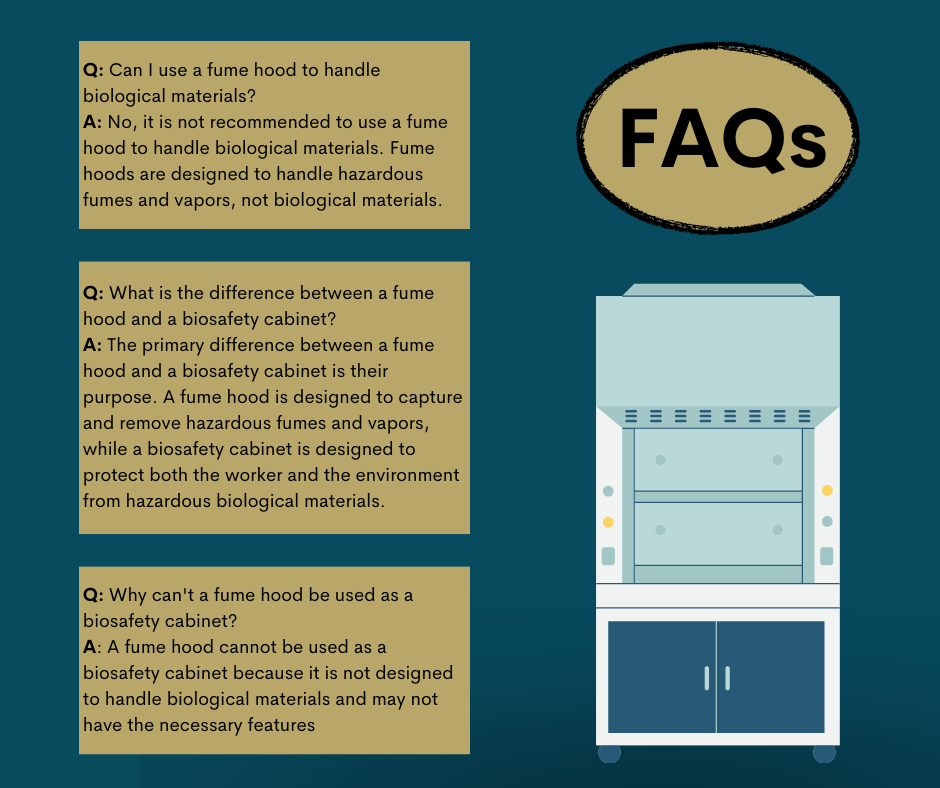Fume hoods and biosafety cabinets are distinct types of laboratory equipment that serve different purposes and should not be used interchangeably. While they may seem similar, they serve different functions and it is important to understand the difference between them. This article will explore the question: Can a fume hood be used as a biosafety cabinet?
Fume Hoods vs Biosafety Cabinets
Fume hoods and biosafety cabinets serve different purposes, and it is important to understand the difference between them.
A fume hood is a ventilation device that is designed to capture and remove hazardous fumes and vapors that may be produced during laboratory procedures. They provide protection primarily for the user.
Biosafety cabinets, on the other hand, are designed to protect the user, the environment, and the materials being worked with from biological hazards like infectious agents and toxins. They provide protection for the user, the environment, and the product.
What is a Fume Hood?
A fume hood is a type of laboratory equipment that protects from hazardous fumes and vapors generated during laboratory procedures. It is a cabinet-style unit with a front-opening sash that allows access to the interior of the hood. The fume hood is designed to protect the user from inhaling hazardous fumes, and it also helps to contain and control the spread of hazardous materials within the laboratory.
Fume hoods can be found in a variety of laboratory settings, including chemical, biological, and pharmaceutical laboratories. They are designed to work in conjunction with laboratory ventilation systems to provide safe, effective, and efficient removal of hazardous fumes.
Advantages of Fume Hoods
Fume hoods are an essential piece of equipment in laboratories and industrial settings that deal with hazardous chemicals, gasses, and vapors. One of the significant advantages of fume hoods is that they protect workers from harmful fumes and vapors by drawing them away from the workers and exhausting them out of the laboratory. This helps to prevent health problems, such as respiratory irritation, dizziness, headaches, and other serious health issues caused by exposure to hazardous substances. Fume hoods also help to prevent the contamination of laboratory equipment and samples by isolating them from harmful chemicals and gases. Additionally, fume hoods provide a safe and controlled environment for handling volatile substances, allowing for more accurate experiments and measurements. Finally, fume hoods can improve the overall efficiency and productivity of a laboratory by providing a clean, safe workspace for researchers and scientists to work in.
What is a Biosafety Cabinet?
A biosafety cabinet (BSC) is a type of laboratory equipment that provides a controlled environment for handling potentially infectious biological materials. Biosafety cabinets are designed to protect the user, the environment, and the samples being handled from exposure to biological hazards.
BSCs are classified into three categories based on the level of protection they provide. Class I BSCs provide the lowest level of protection and are used for relatively low-risk procedures, such as the handling of non-pathogenic microorganisms. Class II BSCs provide a higher level of protection and are used for procedures involving moderate to high-risk microorganisms. Class III BSCs provide the highest level of protection and are used for procedures involving highly hazardous microorganisms, such as those that cause serious or lethal infections.
Advantages of Biosafety Cabinets
Biosafety cabinets, like fume hoods, are also designed to protect laboratory workers and the environment from hazardous materials. However, unlike fume hoods, biosafety cabinets are specifically designed for handling biological materials. They have features such as HEPA filters and ultraviolet lights that make them effective at inactivating harmful microorganisms. Biosafety cabinets also have a sealed design that reduces the risk of contamination, ensuring the safety of both the worker and the environment.
Can a Fume Hood be Used as a Biosafety Cabinet?
While it may seem tempting to use a fume hood as a biosafety cabinet, it is not recommended. By understanding the differences between these devices, laboratory workers can ensure that they are using the appropriate equipment for their specific needs and that they can work safely and effectively with hazardous materials. The ventilation system of a fume hood is not designed to handle biological materials, and it may not have the necessary features, such as HEPA filters, to provide adequate protection. In addition, the design of a fume hood is not sealed, which increases the risk of contamination.
Using a fume hood as a biosafety cabinet is not only dangerous, but it is also against regulations. Most laboratory facilities have strict regulations in place to ensure the safety of workers and the environment, and using a fume hood as a biosafety cabinet is a violation of these regulations.
With over two decades of experience, National Laboratory Sales is dedicated to transforming your lab with personalized service and innovative design solutions. Whether you’re building a state-of-the-art new lab or upgrading your current space, we offer a remarkable range of high-quality casework, workstations, fume hoods, and other essential lab products. Plus, most of our items ship fast—often within two weeks—so you can keep your projects on track. Experience a new standard of lab solutions. Contact us today!
Related Resources:



